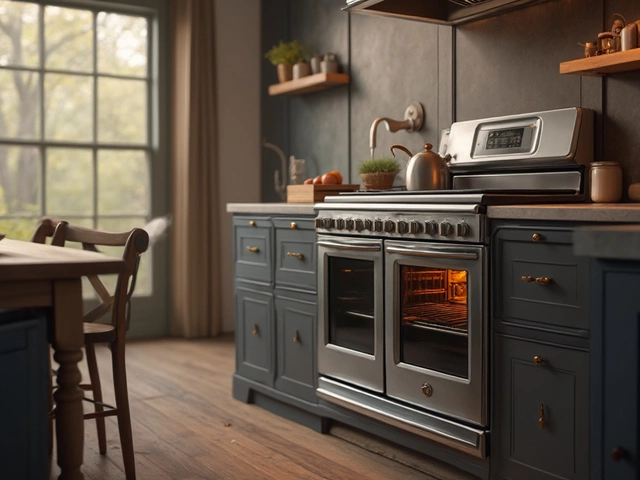So you’re staring at that stubborn old electric oven, right? The temperature’s off, the finish is scratched, or maybe it just won’t turn on and the only thing it’s cooking is your patience. Before you start Googling ‘oven replacement service near me,’ you might wonder—how hard is it really to swap out one electric oven for another?
Here’s the first thing: most electric ovens are more or less the same size, but—surprise—there are little differences that can drive you nuts. The power cord location might not line up, the plug might not fit your outlet, and sometimes you have to deal with awkward cabinetry. Manufacturers love to claim their models are ‘universal fit,’ but my kitchen said otherwise. If it’s your first time, don’t expect it to slide in like Tetris. Measure everything twice. Measure the oven, the opening, and the distance from the back wall to the socket. Even a half inch off will make you want to invent new swear words.
- What Makes Oven Replacement Tricky?
- Tools and Prep: What You Actually Need
- The Big Steps (and where people mess up)
- DIY or Pro: How to Decide
What Makes Oven Replacement Tricky?
The old oven might look simple enough, but when you try to pull out an electric oven and slide in a new one, things can get dicey fast. For starters, not all ovens are exactly the same size—even if they’re labeled 30-inch or 27-inch. Builders often forget that the cabinets might be a hair too tight (or loose), and sometimes countertop lips or floor tiles block things from fitting. That’s why people end up busting out a measuring tape three times during the process.
Here’s another thing that trips folks up: wiring. Most electric ovens use a 240-volt hookup. These aren’t your average plugs—these are beefy, power-hungry connections. It’s not always as simple as unplugging a toaster. Some ovens are hardwired straight into the circuit—you have to cut power at the breaker, unscrew the wires, and hook up the new one by matching color-coded lines. If you’re not used to dealing with high-voltage lines, this can be stressful and a little scary. Mess this up, and you can fry your new oven or worse.
Also, don’t forget local rules. Some cities require a permit to work with electrical wiring, and if your oven isn’t installed right, a home inspector or insurance company can give you trouble down the line.
- Varying oven dimensions—even small differences matter
- Power connections (plug-in vs. hardwired setups)
- Awkward kitchen spaces and tight cabinetry
- Local safety codes and building permits
- Physical heft—the average 30" electric oven weighs 130 to 220 lbs
On top of that, a 2023 kitchen appliance survey showed that nearly 48% of DIY oven replacements hit a snag with the electrical hookup or the fit inside the cabinet.
| Problem | % of DIYers Affected |
|---|---|
| Electrical connection issues | 33% |
| Cabinet fitment issues | 28% |
| Physical difficulty (weight, moving) | 18% |
| Permits/code confusion | 11% |
If you want to replace electric oven units without drama, knowing about these headaches ahead of time will make your life easier. And to really dodge problems, double-check everything—wires, measurements, and even the manuals—before you wrestle the oven out of its spot.
Tools and Prep: What You Actually Need
If you want to replace electric oven without a hitch, the right gear and prep will make or break your day. Most ovens are heavy and surprisingly awkward, so don’t wing it with your basic toolbox. You need tools that actually work for kitchen appliances, not just stuff you find lying in your garage.
- Screwdriver set: You’ll probably need both Phillips and flathead. Some oven panels use weird screws, so a set with different sizes is safest.
- Voltage tester: This is a must. Electric ovens use 240 volts and you do not want to guess whether that line is live. A proper tester costs around $10-$20 and can literally save your life.
- Adjustable wrench or socket set: If your oven is hardwired, you’ll have connections to loosen and tighten.
- Sturdy work gloves: Ovens have sharp edges, and the back collects crumbs and random sticky stuff. Don’t go in bare-handed.
- Appliance dolly or strong friend: These things are heavy—think 130 to 220 pounds. Straining your back isn’t worth it.
- Measuring tape: Double check every measurement—oven, cutout, and power cord length.
It’s smarter to unplug your oven and turn off the circuit breaker at the panel, not just at the wall. Most home fires from appliances start during repairs or installations when someone skips this step. For perspective, the National Fire Protection Association says that faulty electrical appliances cause roughly 13% of all home structure fires from 2018 to 2022. That’s a good reason to get serious about prep.
| Tool | Why You Need It |
|---|---|
| Voltage Tester | Checks if wires are live, keeps you safe |
| Screwdrivers | Removes/install oven panels, secures oven in place |
| Measuring Tape | Ensures the new oven fits your space |
| Wrench/Socket | Connects or removes wiring nuts or brackets |
| Gloves | Protects hands from cuts and dirt |
| Dolly/Helper | Helps safely move heavy appliance |
Before you even look at your new oven, check the power setup. Is your wall outlet three-prong or four-prong? New ovens in the U.S. usually need a four-prong cord, but a lot of older homes still have three. You can change cords, but don’t just shove the old one onto your new oven. Most manuals actually void the warranty if you DIY the wrong cord. Take five minutes—Google your model and check their cord recommendations.
Another tip: have your owner’s manuals handy for both the old and new ovens. Some brands hide the reset screws or wire nuts in weird spots. With a manual, you can skip the stress of pulling the thing halfway out, then pushing it back in to hunt for a hidden screw. Trust me, you’ll thank yourself later.

The Big Steps (and where people mess up)
Alright, so you’re ready to rip out the old oven and slide in the new one. Here’s how the process actually looks in real kitchens, not in showrooms. Reality check: This isn’t just unplugging and replugging. There’s a sequence to follow if you want to avoid breaking stuff—or hurting yourself.
- Turn Off the Power
Sounds simple, but tons of people forget. Head to the breaker box and shut off the power for your oven’s circuit. Don’t just rely on an on/off knob. Use a voltage tester to double-check there’s no electricity flowing. This is how you avoid getting zapped, and yes, people still mess this up every year. - Disconnect the Old Oven
Most ovens are hardwired or plugged in behind or under the unit. Pull the oven out (watch your back!) and disconnect the wire nuts or unplug it. If it’s hardwired, take a pic of the wiring setup with your phone so you can copy it later. Got a gas-electric combo? Double check—you’re probably going to need a pro for that. - Check the New Oven’s Specs
The most common mistake? Not checking the amperage or making sure the plug matches your outlet. A lot of newer ovens need a 40 or 50 amp circuit. Plug and cord styles changed over the years—so double check before you start hauling your new oven around. - Wiring and Leveling
Time to wire up the new oven. Follow the photo you took or the diagram in the manual. Secure the oven’s wires with wire nuts—loose wires are a fire hazard. Once it’s powered, check that it sits level, otherwise you’re in for lopsided cakes and runaway casserole juices. - Test Everything Before You Finish Up
Flip the breaker back on and try all oven settings, especially broil and bake. Check interior lights and preheat to make sure nothing smells weird or sounds off. If you skip this and shove it back in the wall, you’ll end up pulling it out again later.
Let’s be real: Most headaches happen in the plug-and-match phase or when people try to wing it without checking wiring codes. And don’t forget, moving a heavy oven is a two-person job. Back injuries land thousands of DIYers in urgent care each year.
For a bit of perspective, check out this data table showing the top pain points from a survey of appliance installers:
| Common Problem | Percentage of DIYers Reporting |
|---|---|
| Wiring confusion | 42% |
| Oven doesn’t fit opening | 31% |
| Damaged flooring/cabinets | 18% |
| Forgot to turn off power | 9% |
If you run into a snag, don’t muscle through out of pride. Sometimes, calling an electrician is just cheaper than fixing fried wires and patching drywall. Swapping out a replace electric oven setup isn’t rocket science, but you do need to take these steps one at a time. No shortcuts, unless you like surprises.
DIY or Pro: How to Decide
Here’s the question everyone hits sooner or later: Should you try to replace your electric oven by yourself, or just hire someone who does it for a living? It’s not always as obvious as you’d think, so let’s break it down with some facts, a bit of common sense, and a look at what might go wrong.
First, check the wiring setup. Most built-in electric ovens run on a 220-240V circuit. If you’ve never worked with those before, it’s not a place to start learning. According to the Electrical Safety Foundation International, electrical failures or malfunctions were the second leading cause of U.S. home fires involving electrical distribution and lighting equipment in 2023. Getting zapped is no joke.
Ask yourself these things before you decide:
- Do you have the right tools: a voltage tester, adjustable wrench, level, and screwdrivers?
- Does your oven plug use a standard outlet, or is it hardwired?
- Are you comfortable lifting 100+ pounds by yourself? (Typical single ovens weigh 80–150 lbs.)
- Is your electrical panel labeled, and do you know how to flip the right breakers safely?
- Is your kitchen floor clear, and can you keep kids and pets out of the way?
On the flip side, calling a pro usually means the job’s done faster, and it comes with a labor warranty. Electricians and appliance installers have insurance in case something goes sideways—something you won’t get if you go full DIY. According to a survey by HomeAdvisor last year, the average price to have a pro install an electric oven is $120–$275, depending on your area and whether extra wiring’s needed. Not terrible for peace of mind if you ask me.
| DIY | Pro Installer |
|---|---|
| No install fee Direct control Big savings if no issues |
Labor/insurance included Warranty on work Done in under 2 hours |
| Risk of injury Possible electrical/code mistakes May void oven warranty |
Higher upfront cost Waiting for appointment |
Bottom line: If your oven matches the old one almost perfectly, and you’ve handled electrical stuff before, doing it yourself might not be a huge leap. But if you see different plug styles, hear strange buzzing, or you’re not sure about tripping breakers, hiring a pro is the safe bet. Either way, nobody’s going to judge you for asking for help—I sure wouldn’t, and my back would thank me later.




